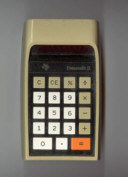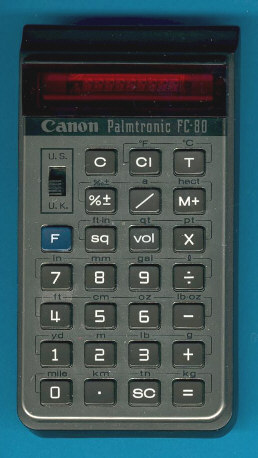
DATAMATH CALCULATOR MUSEUM
 |
DATAMATH CALCULATOR MUSEUM |
Canon FC-80
| Date of introduction: | 1974 | Display technology: | LED-stick |
| New price: | $130.00 | Display size: | 8 |
| Size: | 5.5" x 3.1" x 1.5" 139 x 78 x 37 mm3 |
||
| Weight: | 6.9 ounces, 197 grams | Serial No: | 600673 |
| Batteries: | 4*NiCd AA or 4*AA Alkaline | Date of manufacture: | mth 12 year 1974 |
| AC-Adapter: | Origin of manufacture: | Japan | |
| Precision: | 8 | Integrated circuits: | Hitachi HD3650, HD3656 |
| Memories: | 1 | ||
| Program steps: | Courtesy of: | Joerg Woerner |
 Canon
introduced already in 1974 with the
Palmtronic FC-80 a full metric conversion calculator. That time it was far ahead
of competition with both U.S. and U.K. conversion constants stored in the
memory. Dismantling the FC-80 gives immediately an answer to the obvious
question:
Canon
introduced already in 1974 with the
Palmtronic FC-80 a full metric conversion calculator. That time it was far ahead
of competition with both U.S. and U.K. conversion constants stored in the
memory. Dismantling the FC-80 gives immediately an answer to the obvious
question:
How could engineers of Canon manage this unbelievable calculator ?
 The
printed circuit board (PCB) of the FC-80 makes use of the Hitachi HD3650
processing chip (CPU), an additional Read Only Memory
(ROM) HD3656, and two display drivers. We know this powerful calculator
architecture already from the Palmtronic F-7 and Canola F-11
scientific calculators.
The
printed circuit board (PCB) of the FC-80 makes use of the Hitachi HD3650
processing chip (CPU), an additional Read Only Memory
(ROM) HD3656, and two display drivers. We know this powerful calculator
architecture already from the Palmtronic F-7 and Canola F-11
scientific calculators.
Even the housing looks familiar to us, it was borrowed form
the F-5.
The FC-80 started a long tradition of metric conversion calculators but it took
8 years until we got with the Texas Instruments Converter
a product with similar performance. Most other metric conversion calculators
like the Canon FC-43, FC-82, Toshiba LC-838,
and
the TI-1889
use a tiny single-chip calculator circuit borrowed form so-called four-bangers.
If you have additions to the above article please email: joerg@datamath.org.
© Joerg Woerner, March 26, 2003. No reprints without written permission.